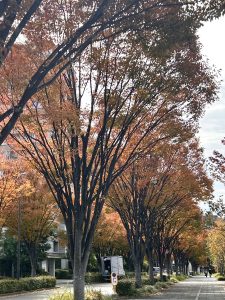日本人は記念日好きなのでしょうか(愛知県名古屋市千種区姫池通 骨董買取 古美術風光舎)
2025.11.11

外に出ると冷たい空気に身を縮めてしまいますが、秋も深まり美しく色づき始めた街路樹のおかげで何とか上を向いて歩いております。この頃は短くなったと感じる秋ですが、紅葉やスポーツなど少しでも満喫できるといいですね。
さて本日11月11日は「1」が4つ並ぶことから記念日が多い日でもあります。日本記念日協定により制定されているものだけで68件もあり、8月8日、10月10日に次いで3番目に多いのだとか。やはりゾロ目の日付は記念日になりやすいのでしょうか。11月11日は棒が並んでいるような形状からも記念日にしやすいようで、ポッキーの日、箸の日、うまい棒の日。11を十一に見立て、電池の日、磁石の日。11をコンセントの差し込み口に見立て、配線器具の日などもあるようで、もうこうなったら何でもありな気がしてきますね。
中国では1が並ぶ11月11日を 「独身の日」としネットなどで大規模なセールが行われるようです。人口が約14億人ですからかなりの購入金額になるとのことで、記念日というよりは一大イベントですね。
その他の国ではどうなのかと調べてみますと、停戦記念日など出来事に由来するものはありますが、1が並んでいるからといって記念日にしている様子はないように思います。もしかして日本人は記念日好きなのでしょうか。そもそも「記念日協定」が存在しているのは日本だけ?などとこれまで普通に口にしてきた「記念日」という言葉が不思議なものに思えてきました。
その日本で最初に制定された記念日は、大正9年に制定された6月10日の「時の記念日」です。日付は日本書紀の記述、「671年4月25日(太陽暦の6月10日)、天智天皇が中国の唐から伝わった水時計を設置した」に由来しています。水時計は漏刻(ろうこく)とも呼ばれ、原理としては4段の水槽の上段から水を注ぎ、一定の速さで水が下段へと落ちていき、一番下の水槽の水の量が増すと、そこに縦に浮かべられた目盛付きの弓矢が浮き上がる仕組みで、その目盛りを読むことで時刻を知り、鐘などを撞いて皆に伝えたようです。もちろん常に正確に測れるわけではありませんでしたが、今が何時かを知ろうとするのは画期的な試みだったはずです。
また話が逸れてきましたが、時計が気になってきましたので、よろしければお付き合いを。
昔の人々は太陽が出たら起き、暗くなったら眠るという生活をする中で、太陽の動きや影の長さから時間の存在に気づいたといいます。狩猟文明から農耕文明に移行すると水害への恐れや、収穫を増やしたいという欲などから暦という考えが生まれ、知恵を絞り、自然にあるものを利用しながら日時計や水時計、砂時計などを発明していきます。
人間の欲望は果てしなく、大航海時代には、出港地点の時刻と現在地の時刻の差から緯度を割り出していたため、正確な位置を知るためには精度の高い時計が必要となりました。そこで王族や貴族が時計の発明者に対して多額の懸賞金を出したことで時計の技術は急速に向上していきました。
私、この年で初めて知ったのですが、クオーツ時計のクオーツとは水晶を指すのですね。水晶は電圧を加えると一定の速度で振動する性質があるそうです。てっきり精巧な機械が仕込まれているのかと思っていましたら、自然の石の力だったとは…。興味が薄いと知らないまま通り過ぎることが多いものです。
時刻を知るという技術は進歩しましたが、なんとなくの時間が分かっていれば生活できていた人々の目には、時間に追われる現代人の姿はどうのように映るのでしょうか。想像がつきそうな気もしますが。
それでは、また次の機会に。(スタッフH)

Stepping outside, the cold air makes me hunch my shoulders, but thanks to the street trees deepening in autumn and beginning to show their beautiful colors, I manage to walk with my head held high. Autumn feels shorter these days, but I hope we can enjoy the foliage and sports as much as possible.
Now, today, November 11th, is a day with many commemorative dates because it features four “1”s in a row. According to the Japan Anniversary Association, there are 68 officially designated ones alone, making it the third most popular date after August 8th and October 10th. Perhaps dates with repeating numbers are just more likely to become commemorative days? November 11th also seems conducive to commemorative days due to its shape resembling sticks lined up: Pocky Day, Chopsticks Day, Umai-Bō Day. Some see the 11 as “eleven” and celebrate it as Battery Day or Magnet Day. Others see the 11 as resembling a power outlet and observe it as Electrical Outlet Day. At this point, it feels like anything goes!
In China, November 11th, with its repeated 1s, is known as “Singles’ Day,” featuring massive online sales. With a population of about 1.4 billion, the total purchase amount is said to be enormous. It’s less a commemorative day and more a major event.
Looking into other countries, while some have commemorative days tied to events like Armistice Day, I don’t see them designating days just because they have repeated ones. Could it be that Japanese people just love commemorative days? Is Japan the only country with a “Commemorative Day Agreement”? Suddenly, the word “commemorative day,” which I’d used casually until now, started to feel rather peculiar.
The first official commemorative day established in Japan was June 10th, designated as “Time Commemoration Day” in 1920 (Taisho 9). The date originates from an entry in the Nihon Shoki: “On April 25, 671 (June 10th in the solar calendar), Emperor Tenji installed a water clock introduced from the Tang Dynasty of China.” Also called a water clock (roukoku), its principle involved pouring water from the top of a four-tiered tank. Water flowed down at a constant rate. When the water level rose in the lowest tank, a vertical, graduated arrow floating there would rise. Reading this scale indicated the time, which was then announced to everyone by striking a bell or similar device. Of course, it wasn’t always perfectly accurate, but trying to know the current time must have been a groundbreaking endeavor.
I’ve digressed again, but since I’m curious about clocks now, please bear with me if you don’t mind.
It’s said that ancient people, living by rising when the sun appeared and sleeping when it grew dark, first noticed the existence of time through the sun’s movement and the length of shadows. As societies transitioned from hunter-gatherer to agricultural cultures, fears of floods and desires to increase harvests gave birth to the concept of calendars. They pooled their wisdom, utilizing natural elements to invent sundials, water clocks, and hourglasses.
Human desire knows no bounds. During the Age of Exploration, determining latitude required calculating the time difference between the point of departure and the current location. This necessitated highly accurate timepieces to pinpoint precise positions. Consequently, royal families and nobility offered substantial rewards to clock inventors, spurring rapid advancements in horology.
I only learned this recently, but the “quartz” in quartz watches refers to crystal. Apparently, quartz crystals vibrate at a constant frequency when an electric voltage is applied. I had always assumed it involved intricate mechanical workings, but it turns out it’s the power of a natural stone… When you lack interest, you often pass things by without knowing.
While technology for telling time has advanced, how must the sight of modern people constantly chasing time appear to those who once managed to live knowing only a general sense of time? I suppose it’s not hard to imagine.
Well then, until next time. (Staff H)
*******************
ご実家の整理やお片付けなどをされている方のご相談などが多くございます。
お片付けなどくれぐれもご無理のないようになさってくださいませ。
風光舎では古美術品や骨董品の他にも絵画や宝石、趣味のお品など様々なジャンルのものを買受しております。
お片付けをされていて、こういうものでもいいのかしらと迷われているものでも、どうぞお気軽にご相談下さいませ。
また風光舎は、出張買取も強化しております。ご近所はもちろん、愛知県内、岐阜県、三重県その他の県へも出張いたします。
なお、毎月21日の持込鑑定会では無料鑑定・買取・ご相談など、ご予約なしで承っております。
ご近所の皆さま、ご遠方のみなさまも、お気軽にお越しくださいませ。
まずは、お電話お待ちしております。
愛知県名古屋市千種区姫池通
骨董 買取【古美術 風光舎 名古屋店】
TEL052(734)8444
10:00-18:00 OPEN
#出張買取#骨董#古美術#骨董品#絵画#版画#茶道具#刀剣#彫刻

